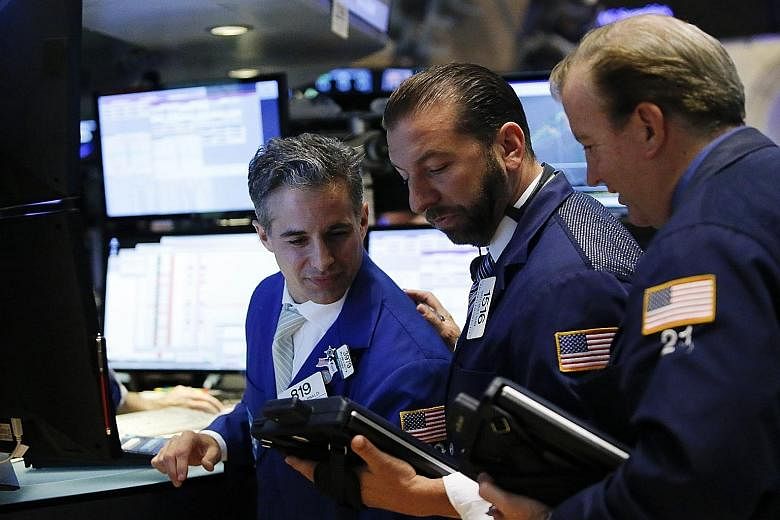The recent stock market sell-off has left many of us scratching our heads as to what we should do about the gaping hole we find in our stock investment portfolios.
Should we buy more shares to average down our holding costs or should we cut our losses and get out of the market completely? It is a tough call to make.
I am reminded of the great British economist John Maynard Keynes' admonition to investors that they should not constantly consider whether they should cut and run in a falling market.
"I do not believe that selling at very low prices is a remedy for having failed to sell at high ones... An investor should be aiming primarily at long-period results and should be solely judged by these," he wrote.
These were brave words of wisdom from Keynes, who was one of history's most successful investors as well as being a highly influential theorist. But these words offer little solace to those who find themselves staring at 30 to 40 per cent losses on the pricey blue chips they bought in recent months.
One particular worry is that the latest sell-off is not the usual vanilla-type stock market correction we are used to seeing in recent years.
Indeed, many younger investors may have not experienced a bear market, let alone invested in a climate of rising interest rates as the US central bank prepares its first hike in almost a decade.
A huge surprise awaits them - and not a pleasant one.
Another concern is that the toxic brew of slowing growth in China, falling commodity prices and the threat of higher interest rates may trigger a 1997-style Asian financial crisis-type disaster.
So what should investors do under these circumstances?
Well, the simple answer is that your decision really depends on why you bought the particular stock in the first place.
CNBC talk host Jim Cramer noted that when he wants to invest in a company, he buys a small number of its shares first and then hopes the stock market would knock it down so he can buy more shares at a better price later on.
Trading - as opposed to investing - is different, however. When trading, he puts his money into the stock all in one go if he believes its price is about to fly. "I buy down when I am investing. I cut my losses immediately when I am trading if the reason I am trading the stock doesn't pan out."
Going by his reasoning, an investor's first objective is to examine the purpose of buying the stock.
When he does so, he will find that more often than not, he bought it because he had fallen in love with a good story about the stock. He may also discover that most of these stories are fairy tales. If this is the case - as Mr Cramer points out - he should cut his losses quickly before the love affair turns sour.
Otherwise, he may find himself turning what was supposed to have been a short-term fling into a long-term loveless marriage.
Worse, unless he sorts out his objectives properly, he may even try to dollar-average the costs of his investment and buy more shares at various price levels as the stock slips in the mistaken belief this will mitigate his risks.
In fact, hoping can cause even more grief. No matter how much an investor likes the story he heard about the stock originally, he should consider selling it if its price falls below its 200-day moving average and keeps dropping after that.
And even if an investor is buying a stock for keeps, there is overall market sentiment to consider.
Fundamental factors play a role in determining stock prices but they are by no means the sole driver. Stock prices are also driven by the order flows made by big-time players and investors' perceptions.
Historical precedents suggest timing an investment around this time of the year is fraught with risks because many of the most famous stock market crashes have been in September and October.
The terrorist attacks on New York's World Trade Center that triggered a market plunge took place 14 years ago on Sept 11, 2001. The collapse of US investment bank Lehman Brothers took place this week seven years ago, triggering the biggest financial crisis since the 1929 Great Depression.
October has been no better. The 1929 Wall Street crash happened in the 10th month and so did Black Monday in 1987 when Wall Street plunged 23 per cent in a day.
October 2008 was a particularly bad month with repeated examples of stomach-churning plunges.
Its first trading day was marked by a 778-point nosedive on Wall Street - its biggest one-day closing drop in history.
Given the odds of further turbulence, my advice to investors is to keep some cash handy and allow the dust to settle on the September and possibly October wobbles before returning to the market.
One indicator that may determine whether it is safe to re-enter the market is likely to be provided by the US Fed.
If only the Fed would be willing to send out a signal that it will continue to provide the support the markets need as it has done over recent years. This would mean we could go back to business as usual in the stock market. But that may just be my wishful thinking.


